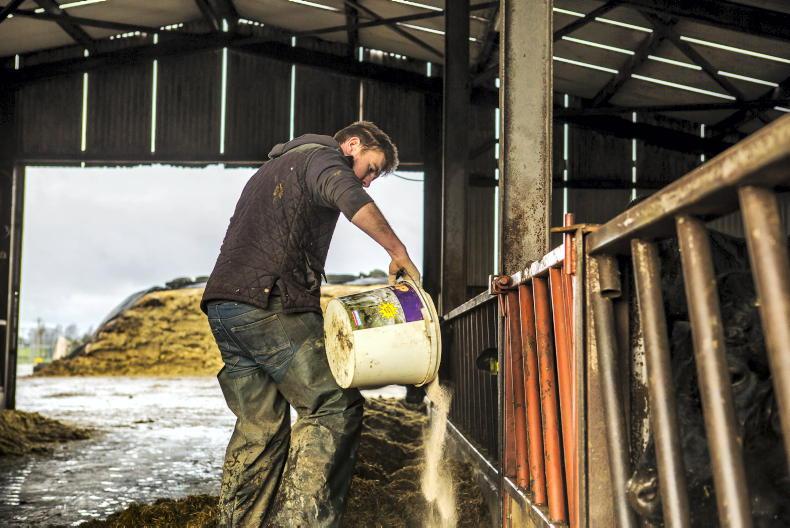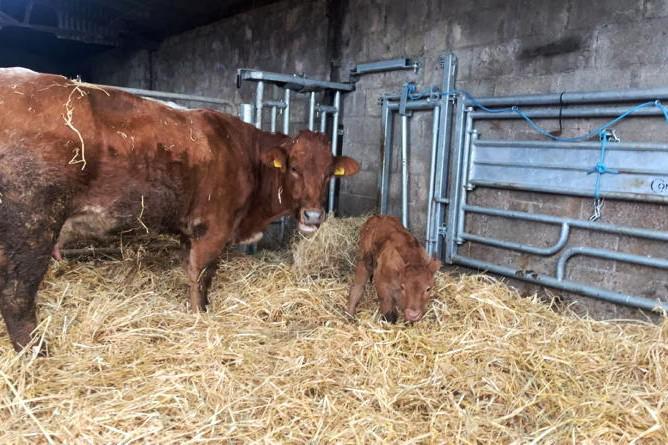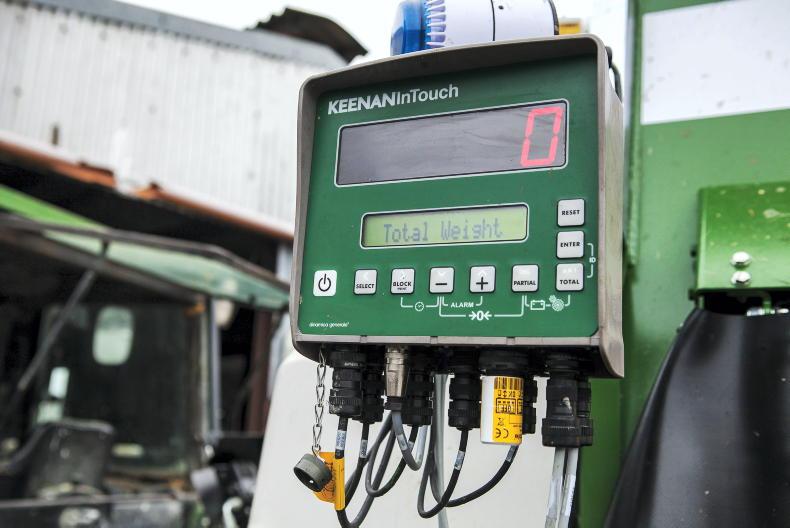January is a usually a quieter month on the programme farms before the surge of spring calving begins late next month.
With a short-term lull in the daily workload, it is a good opportunity to carry out a few essential tasks to prepare for spring calving.
The farmers will also use the time for other tasks, such as benchmarking to review herd performance last year and to set the farm up for the year ahead. Outlined are five management tasks to complete during January.
1 Benchmarking
How did your suckler herd perform during 2020? Benchmarking the farm is the best way to assess the financial and physical output of the herd and is offered as a free service to BDG members through your local CAFRE adviser.
The earlier this task is carried out the better. The report will allow you to make cost-effective changes to the finishing system, calving management and key inputs, such as fertiliser and concentrate.
Leaving benchmarking until later in the year will be too late to alter the areas where herd performance is below optimal levels.
2 Weighing cattle
Weighing cattle will give an accurate assessment of animal performance on the winter diet.
It will indicate if replacement heifers are on track to meet minimum target breeding weights by May or June.
Where the 2020 spring-born bulls are destined for slaughter under 16 months of age, an accurate weight recorded in January will also determine when animals are likely to be finished.
Target slaughter weight for young bulls on the programme farms is around 680kg, yielding a carcase weight of 390kg to 400kg. This means March-born bulls should weigh in the region of 550kg by the time they reach 12 months of age and at least 450kg by early January.
Bulls which are below the outlined target weights will struggle to reach the target finishing weight, as well as the required fat class, before they reach 16 months of age.
Identifying these animals in January gives more time to alter feed plans or to reconsider finishing these animals as young bulls.
3 Pre-calving minerals and vaccines
Vaccines should also be given now to prevent problems such as calf scour, especially if cows and calves are likely to remain housed for a short period before turnout to grass.
Cows should be offered pre-calving minerals from six to eight weeks before they calve down. Powdered minerals can be offered by dusting on silage every day, or alternatively pre-calving minerals can be given as a bolus and lick buckets.
Feeding minerals will cut down on the number of cows which are lethargic at calving time or animals holding the placenta post-calving. Calves will also be livelier and faster to suckle their dam.
Having cows penned according to predicted calving dates makes feeding minerals much easier to manage.
For example, by grouping all cows set to calve in the first six weeks together means these animals can be targeted with minerals from January onwards.
For the cows that will calve in the second half of the calving period, feeding minerals can be delayed for a few weeks, which will be a cost saving.
4 Get calving pens and aids ready
January is the time to wash down and disinfect calving pens, especially if they have been used to house sick animals or quarantine recently bought-in stock.
Calves are born without immunity and if calving pens are dirty and soiled from housing sick animals, there is a risk that these pathogens can be transmitted to newborn calves. On the majority of suckler farms, there will be a cow or heifer that calves down ahead of the predicted calving date. Having all calving aids restocked and located in the calving shed will save time should an early calving animal require assistance. Replace or install new gates and work lights as necessary now.
5 Soil sampling
Make January the month to take soil samples. Cattle will be housed since October, so ground will be well rested and samples taken now will not be distorted by slurry, or livestock manure and urine.
By sampling soils in January, the results can be used to draw up a fertiliser plan for the year ahead.
Slurry can then be targeted to the fields which are low in phosphate (P) and potash (K) once the closed period finishes, before topping up with compound fertiliser and straight nitrogen (N) products.
Take soil cores every 10 to 15 steps as you walk across a field. Walking in a zigzag or random direction gives a better reflection of soil type compared with walking in a straight line.
Place all soil cores in a bucket as you walk the field. When each field is finished, mix the cores together and fill the soil in a plastic bag and label it.
As a rule, the maximum sample area should be around 10 acres. So, for larger fields, you will need to take multiple samples within the same field.
For smaller fields around one to two acres, located in the same land block and get similar fertiliser treatments, group these paddocks as a single sample.
If sheep have been grazing on farm during winter, leave fields for six to eight weeks before taking samples.
Read more
Is your farm ready for the cold snap?
Bullocks slaughtered on Newford Farm sell for €70 per head higher than 2019
January is a usually a quieter month on the programme farms before the surge of spring calving begins late next month.
With a short-term lull in the daily workload, it is a good opportunity to carry out a few essential tasks to prepare for spring calving.
The farmers will also use the time for other tasks, such as benchmarking to review herd performance last year and to set the farm up for the year ahead. Outlined are five management tasks to complete during January.
1 Benchmarking
How did your suckler herd perform during 2020? Benchmarking the farm is the best way to assess the financial and physical output of the herd and is offered as a free service to BDG members through your local CAFRE adviser.
The earlier this task is carried out the better. The report will allow you to make cost-effective changes to the finishing system, calving management and key inputs, such as fertiliser and concentrate.
Leaving benchmarking until later in the year will be too late to alter the areas where herd performance is below optimal levels.
2 Weighing cattle
Weighing cattle will give an accurate assessment of animal performance on the winter diet.
It will indicate if replacement heifers are on track to meet minimum target breeding weights by May or June.
Where the 2020 spring-born bulls are destined for slaughter under 16 months of age, an accurate weight recorded in January will also determine when animals are likely to be finished.
Target slaughter weight for young bulls on the programme farms is around 680kg, yielding a carcase weight of 390kg to 400kg. This means March-born bulls should weigh in the region of 550kg by the time they reach 12 months of age and at least 450kg by early January.
Bulls which are below the outlined target weights will struggle to reach the target finishing weight, as well as the required fat class, before they reach 16 months of age.
Identifying these animals in January gives more time to alter feed plans or to reconsider finishing these animals as young bulls.
3 Pre-calving minerals and vaccines
Vaccines should also be given now to prevent problems such as calf scour, especially if cows and calves are likely to remain housed for a short period before turnout to grass.
Cows should be offered pre-calving minerals from six to eight weeks before they calve down. Powdered minerals can be offered by dusting on silage every day, or alternatively pre-calving minerals can be given as a bolus and lick buckets.
Feeding minerals will cut down on the number of cows which are lethargic at calving time or animals holding the placenta post-calving. Calves will also be livelier and faster to suckle their dam.
Having cows penned according to predicted calving dates makes feeding minerals much easier to manage.
For example, by grouping all cows set to calve in the first six weeks together means these animals can be targeted with minerals from January onwards.
For the cows that will calve in the second half of the calving period, feeding minerals can be delayed for a few weeks, which will be a cost saving.
4 Get calving pens and aids ready
January is the time to wash down and disinfect calving pens, especially if they have been used to house sick animals or quarantine recently bought-in stock.
Calves are born without immunity and if calving pens are dirty and soiled from housing sick animals, there is a risk that these pathogens can be transmitted to newborn calves. On the majority of suckler farms, there will be a cow or heifer that calves down ahead of the predicted calving date. Having all calving aids restocked and located in the calving shed will save time should an early calving animal require assistance. Replace or install new gates and work lights as necessary now.
5 Soil sampling
Make January the month to take soil samples. Cattle will be housed since October, so ground will be well rested and samples taken now will not be distorted by slurry, or livestock manure and urine.
By sampling soils in January, the results can be used to draw up a fertiliser plan for the year ahead.
Slurry can then be targeted to the fields which are low in phosphate (P) and potash (K) once the closed period finishes, before topping up with compound fertiliser and straight nitrogen (N) products.
Take soil cores every 10 to 15 steps as you walk across a field. Walking in a zigzag or random direction gives a better reflection of soil type compared with walking in a straight line.
Place all soil cores in a bucket as you walk the field. When each field is finished, mix the cores together and fill the soil in a plastic bag and label it.
As a rule, the maximum sample area should be around 10 acres. So, for larger fields, you will need to take multiple samples within the same field.
For smaller fields around one to two acres, located in the same land block and get similar fertiliser treatments, group these paddocks as a single sample.
If sheep have been grazing on farm during winter, leave fields for six to eight weeks before taking samples.
Read more
Is your farm ready for the cold snap?
Bullocks slaughtered on Newford Farm sell for €70 per head higher than 2019










SHARING OPTIONS